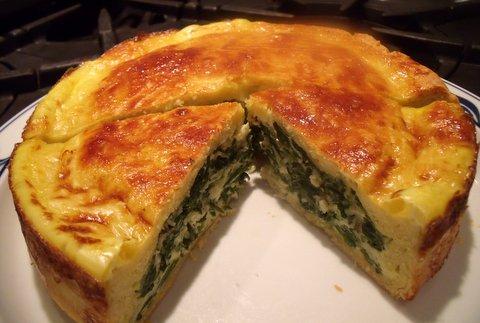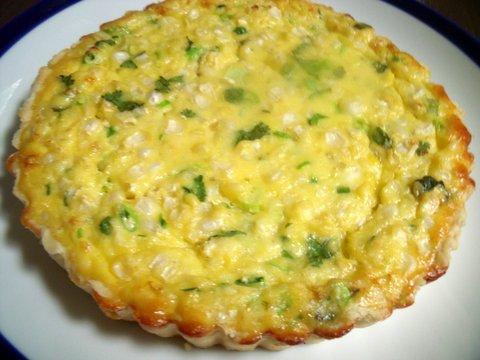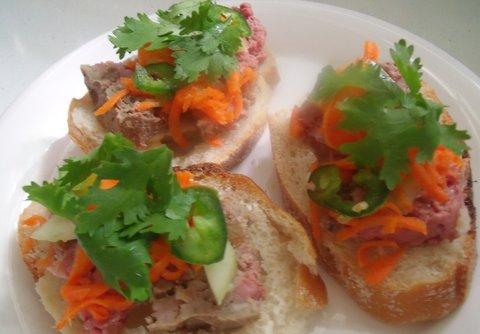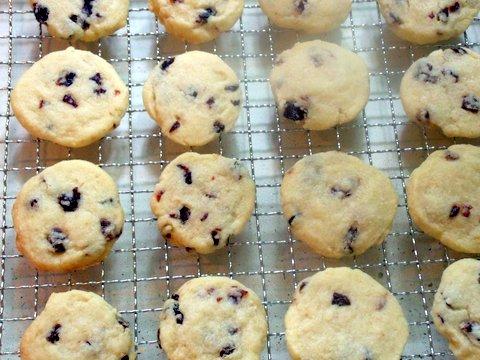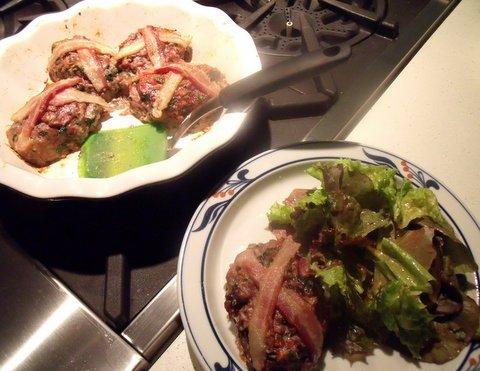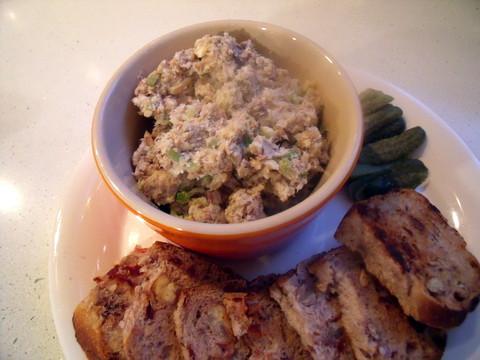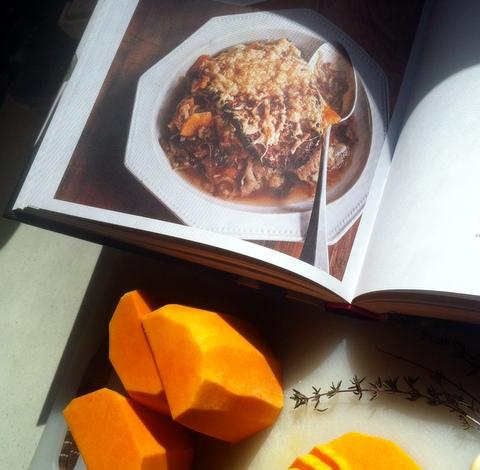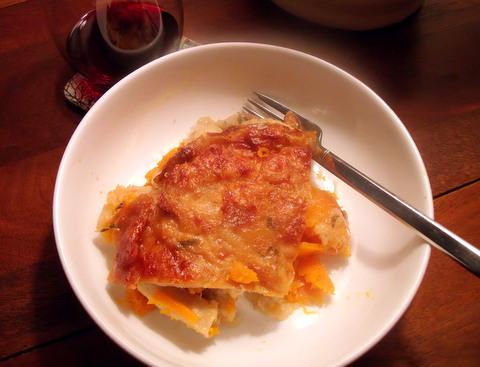
LindaK
eGullet Society staff emeritus-
Posts
3,028 -
Joined
-
Last visited
Content Type
Profiles
Forums
Store
Help Articles
Everything posted by LindaK
-
dcarch, beautiful. It looks like you peel your tomatoes, yes? Do you use the quick dip in boiling water method? When I do that, it always makes the flesh a little soft--fine if you're going to cook the tomatoes. Yours still look very firm. What's your secret?
-
It was baked in a springform pan. Mine has 2.5" sides so you can get that height, which I like. The only tricky part was the olive oil dough. It's a lot softer than dough made with cold butter, especially with the egg addition. I chilled it for maybe 90 minutes before I rolled it out (this recipe was a last minute dinner decision, not a carefully thought out plan. It was getting late and I was hungry!) It was still somewhat soft, so when I lined the springform, the dough wanted to collapse and couldn't be neatly pressed against the sides. Solved by draping it over the edges and quickly adding the filling. Next time I will let it chill longer. The leftovers made a great picnic lunch today. A swiss chard skeptic was converted.
-
Bumping this up to report on a new favorite olive oil pastry dough. Yesterday I tried Nick Malgieri’s version from “How to Bake.” Because it includes eggs and a bit of baking powder, it’s different than the version that uses only flour and olive oil—lighter, slightly bready, tender rather than crisp, the olive oil flavor more subtle than pronounced. Very easy and very good. He uses it in his swiss chard tart, I used it for a similar swiss chard and artichoke pie.
-
Swiss chard and artichoke pie, loosely based on a recipe from Marcella Hazan in Marcella Cucina. The vegetables are bound by a mixture of ricotta, parmesan, and egg, with onions and herbs adding extra flavor. The crust is made with olive oil rather than butter. Very, very good.
- 246 replies
-
- 10
-

-
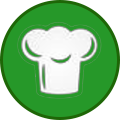
-
I'll check out the blog, thanks for pointing it out. http://gaaarp.wordpress.com/2011/01/09/corn-pudding-tart-modbak/ edited to add link (I think this is the one you referenced, Anna)
-
Member Laura Pazzaglia of the Hip Pressure Cooking blog has a cookbook of that name, just released. Congratulations Laura! Hip Pressure Cooking
-
Another savory tart from Malgieri's The Modern Baker: Corn Pudding Tart Very simple and incredibly delicious. Make it now while fresh corn is in season. Grated and cut fresh corn, scallions, chiles, cream, eggs. Mostly corn, the egg and cream are there to bind, not take over. I did a bit of tinkering with the recipe, swapped cilantro for chives. Omitted butter in the filling, figured between the pastry and cream, it was rich enough (it was), and didn't miss it. I will be making this again soon.
-
David Lebovitz has a Paris pastry app that provides reviews, photos, maps, etc. for more than 370 patisseries, chocolate, and ice cream shops in Paris. It’s searchable by category and location, so you can easily find a recommendation wherever you happen to be. It also includes a list of his favorite patisseries and a glossary/dictionary of French baking terms and food items. And an updated version was just released last week! I bought it just for fun. It’s available on iTunes. If you want to preview a sample before purchasing it, you can download the “lite” version for free. https://itunes.apple.com/us/artist/secrets-of-paris/id475338195 Have a great trip. Let us know of any fabulous pastry discoveries.
-
A great idea from Andrea's web site (and it's in the book): banh mi crostini I'd been looking for ways to use surplus pate, and this struck me as brilliantly simple and delicious. Sorry for the sloppy photo: If you have appropriate leftovers, it is easy and quick to put these together: season some mayo, make some quick pickles (I used cukes and carrots), slice some jalapenos and snip some cilantro. In little time, I had bite-size banh mi flavor, perfect for snacking or offering with drinks. Of course this isn't just for leftovers, you can make fillings specifically for a banh mi party as Andrea did.
-
Andie, yes, you're right. What I should have said was that I personally find the small, hand-held julienne tools inefficient for generating much volume, so I use mine primarily for garnishes. If I I want a bowl full of julienned anything, I use my Cuisinart or would look for the kind of rotary cutter you describe. It all depends on what you want to accomplish, hence my question to the OP.
-
Hi Janet, welcome to the Forums. A question for you: what do you want to do with this tool? Your links are to gadgets that do different things--julienne, a general peeler, or both. Those are very different uses. A julienne is usually for a garnish, while the peeler is more versatile--removing the external skin, cutting fine ribbons, etc. I use my peelers all the time, my julienne tool rarely. Depending on what you want to cook, you may not need the julienne tool at all, at least not now. I personally like the straight peelers. The Cuisinart disk that rotuts mentions is a godsend if you do a lot of shredding. I use mine for veggies, fruit, cheese, chocolate. Easier, faster, and safer than using a box grater.
-
Soba, go for it. Another duck installment: Duck Terrine with Figs Rustic patés like this are very simple to make, so kudos to David for encouraging home cooks to give one a try. This one is a mixture of duck, pork, and chicken livers. It’s a nice blend, well flavored, and the addition of figs (or another dried fruit) add a sweet note. I made this for an important family gathering, so was more concerned with excellent results than with perfect recipe testing. For the most part I followed the recipe as written, with only a couple of tweaks—part personal taste, part recipe correction. Personal taste: the recipe calls for adding chopped cornichons and their liquid to the mixture. I prefer to offer the cornichons on the side, so didn’t include them. Plus I added ½ tsp of curing salt to the final mixture, since I prefer my patés to retain some of their pink color. Recipe concern: there’s an awful lot of liquid in this recipe: ½ cup of brandy, ¼ cup of cornichon pickling juice, 2 eggs. There isn’t any panade or binder to soak it up. It looked like a lot to me. Plus you puree the chicken livers, so they’re more fluid than solid. So I proceeded with caution, first omitting the cornichon juice, then holding off adding the second egg. Even so, the finished mixture was extremely loose. It certainly didn’t hold together. Had I added the juice and another egg, it would have been almost pourable. Though the terrine is baked in a loaf/terrine pan and weighed down afterwards (and so extra liquid and fat would be pressed out), I was still worried. I ended up adding extra ground pork to increase the solids and omitted the second egg entirely. Since my experience making patés is limited, it would be helpful to hear from someone more knowledgeable on this point. After consulting similar recipes in other French cookbooks, I concluded that in the future I’d reduce the brandy before adding it (or just use less). You want the flavor, not the liquid. And I would continue to leave out the cornichon juice. The finished terrine was excellent, though the extra pork made the duck less dominant than it would have been otherwise. All in all, a good basic recipe. Everyone loved it, even folks who swore they hated liver. A crowd of 30 finished half of the terrine, which is good sized. Luckily I got to take the leftovers home. The slice above, accompanied by another of sliced garden tomatoes with basil and vinaigrette, made a very welcome supper for yesterday's hot, humid evening. Since the terrine benefits from sitting in the fridge for a few days, this is a great option for entertaining without last minute preparations.
-
Duck fat cookies A bonus of buying duck for the counterfeit confit and the duck terrine with figs (now ripening in the refrigerator) was a cup of rendered duck fat as well as a carcass for stock. I figured I’d try these cookies. Wow. These are so delicious, but so very rich. They’re sablés, French sugar cookies, with duck fat subbing for most of the butter. They fall squarely in the savory cookie category that was made popular by Pierre Hermé, so they’re more for drink nibbles than dessert. There are lots of variations on the theme—see Dorie Greenspan’s Around My French Table for seaweed (for which she credits David) and olive. But the duck fat adds a whole new dimension. It’s subtle but unmistakable. I made mine with chopped dried cherries, plumped in brandy. The flavors all come together beautifully. I can see playing around with this, maybe even adding some finely chopped duck cracklings. I found the cookie dough to be a bit dry, so would add a little more fat next time. If you have some extra duck fat on hand, give these a try.
-
Last night’s dinner: Counterfeit duck confit. It’s very good and almost effortless. You do need to plan in advance, though. The duck legs need to marinate overnight in their spice rub, and the cooking time is long so that it can be done at low temperature—which lets the fat render without burning and keeps the meat from becoming stringy. I omitted the gin from the marinade because I loathe the flavor, and the spice rub is pretty flexible so you could tweak it to suit your own tastes. The important thing is to follow David’s directions for packing the duck legs close together in the pan, it keeps them partially submerged in the flavorful fat as they cook. The meat doesn’t have the velvety texture of long-preserved confit but it wouldn’t be fair to expect it. It does deliver the flavor and crispy skin of a good confit, which is pretty awesome for all of 10 minutes of active prep work.
-
Andrea Nguyen has a new cookbook, The Banh Mi Handbook. Lots of cook-off worthy recipes there, most likely. I'm considering it...
-
So I finally made the caillettes again, this time not cooking the pork/liver mixture before baking them. To properly test David's recipe, I otherwise followed the recipe (except for leaving out the lemon juice, I didn't have a lemon handy). Results: delicious. I baked them for the 30 minutes as instructed, which yielded an internal temp of 165F, which I figured was sufficient to cook the liver (I would like to know if that's true), Then I let them sit for ~10 minutes before serving them with a salad. They really were like mini pates, rustic in style, very well seasoned and moist, not at all overcooked. Good leftover the next day when brought to room temperature. The only suggested I would add to David's would be to serve them with a good baguette, mustard, and cornichons. Like any country-style pate, it calls out for them. I made the caillettes smaller than David did, but they are rich so smaller was plenty for me. These would be nice for a buffet or dinner party.
-
Are you familiar with Anadama bread? It's a soft but hearty sandwich bread, slight nutty from the addition of fine cornmeal and slightly sweet from molasses (which you can adjust to taste). It's delicious and pairs well with just about anything. Keeps and freezes well too. There are some mentions of it in these previous topics, but it's easy to find recipes online. http://forums.egullet.org/topic/124319-the-bread-topic http://forums.egullet.org/topic/59998-the-bread-bakers-apprentice-by-reinhart/
-
After having read through this book and making a few more recipes, I’d give it a qualified recommendation. The primary attraction, for me, is the writing. David’s a terrific writer and his tales and descriptions of shopping, cooking, and eating in Paris are a joy to read. It brings back a lot of memories for me. Recipes are another matter. Most of the recipes here are standards that you’ll find in other general French cookbooks, others are more original. Nothing wrong with that. But the editing is poor, which has been noted here before. And it happened again last night. I followed David’s recipe for celery root purée, which calls for cooking a potato that never gets used. If you’re comfortable “fixing” recipes on your own, you can get past things like this, no big deal. But if I was making something unfamiliar, I'd probably check the recipe against another version. Easy for me to say, I have a couple of dozen French cookbooks on my shelves. I took a look through the Chowhound discussions in the link above and there are mentions of grammatical errors in the use of French words and terms, but that’s a different editing problem.
-
In addition to the list in Heidi's link, a few more recent films that I enjoyed: Haute Cuisine Jiro Dreams of Sushi Julie and Julia
-
Bump. Any new recommendations out there? I'll be in Montreal later this week and will have a lunch and dinner on my own over the weekend. Staying downtown but don't mind a taxi or subway ride if it's worthwhile.
-
Caillettes—Pork and Chard Sausages This recipe called out to me. First, because caillettes seem like easy, individual pates. Second, because David says he learned the dish from a little Paris wine bar-restaurant, Le Verre Volé, that I remember fondly. The ingredient list sounded good—ground pork, chicken livers, swiss chard, onions, garlic, egg, bacon, herbs and spices. But the recipe itself had me concerned—it calls for cooking the pork and livers first, mixing the ingredients, forming patties, and then baking them. Why cook the meat first? The recipe says to bake the formed caillettes until the meat is cooked through. But it’s already cooked through…I was skeptical. Against my better judgment, I followed the recipe but I would advise you to do otherwise. The mixture held together when I formed them into the quenelle shape but barely. The results were well seasoned but despite the bacon slices on top, the caillettes were as dry as I feared. Only afterwards did I do some homework on caillettes. There are lots of recipes online and on my bookshelf I found one in Julia Child’s MTAFC Vol. 2. They all share similar ingredient lists, but I didn’t find one that called for cooking the meat first. I like the concept of this recipe so will try it again, this time grinding the pork and liver together and mixing other ingredients with the raw meat. If anyone has a better idea, I’d be interested. I took a photo but my camera’s not cooperating, if I can post it later I will.
-
Two more recipes to report on-- Rillettes de Sardines. Very simple and very tasty. I was out of capers so subbed some finely minced cornichons. Served with toasted whole wheat bread with dried cranberries and walnuts. Excellent combination. This will make it into my regular rotation. Though in the Appetizer section of the cookbook, and I can easily see it as part of a light supper with some soup. I also tried the Pissaladiere. While I was able to cover the pan with the dough in a thin layer without much problem, I'll admit that I prefer the bready style dough I'm used to. The topping is classic and simple. As for the anchovies, I don't like big bites of the little guys, maybe I just can't get good ones. But do like the hint of brininess they offer, so what I did was toss a few of them in with the onions towards the end of their long cooking so that they just dissolved into the topping. Good olives are a must. No picture of this one, sorry.
-
OK, I’m on board. I hesitated to buy the book because I have dozens of French cookbooks so I’ve become choosy. But I went ahead and am so glad that I did. The writing and photos alone are worth the price of admission. If you enjoy David’s blog, this book is a joy. If you’ve spent any time living and cooking in France, it will bring back memories that will make you weep. Or at least jealous. My first effort was tasty but not a home run: Panade de Butternut (Butternut Squash Bread Soup). Though it’s spring, I had a squash hanging around and this seemed right for current cold, wet evenings. It’s basically a savory bread pudding with layers of sourdough bread, butternut squash, sautéed onions, and cheese. Plus: great flavors, simple to assemble, no special equipment or ingredients (except for homemade chicken stock, absolutely necessary). Leftovers tasted even better. Con: The bottom bread layer was heavy as lead, I think because the recipe has you add a lot of chicken stock to the final assembled dish before baking, even AFTER you’ve already moistened each layer. Clearly it did not need that much stock. I’ll try this recipe again, next time skipping the extra stock at the outset, and instead checking the panade during baking, basting with stock as needed. Following the recipe as written ends up with a final dish that doesn’t look remotely like the photo in the book. That could also explain my results. The book photo shows what looks like separate, individually assembled panades, with layers of well-toasted bread slices filled to overflowing with the squash and onions, like a soupy sandwich. See photo: By contrast, the recipe has you layer the bread in a baking dish to cover, breaking the bread slices if necessary. So you end up cutting the final panade into squares or wedges, and the bread doesn’t have the toasty crustiness that’s so appealing in the photo, and maybe prevents the soggy lower layer. My result: I have some other small quibbles with the recipe but nothing major. I will make this again when butternut squash is back in season, not only adjusting assembly but also upping the amount of herbs.
-
Sad, terrible news. My heart goes out to his family. Like others, I enjoyed Steven's smart, witty writing. His many affectionate stories involving PJ were always special. As a volunteer, I was in awe of his tireless efforts in support of this community. All wrapped up in a kind, generous, and thoughtful guy. Steven’s legacy, like his personality, will always be larger than life. We’re all lucky to have crossed paths with him, however briefly.
-
My experience is mostly with red kuris and sugar pumpkins, but if they're mostly interchangeable, my favorite things to do with them are making soup, gratins, and stuffing/baking them whole. Andrea Nguyen's web site Viet World Kitchen recently posted suggestions for Asian Pumpkin Recipes and calls out kabocha squash as one of her favorites, worth checking out.

